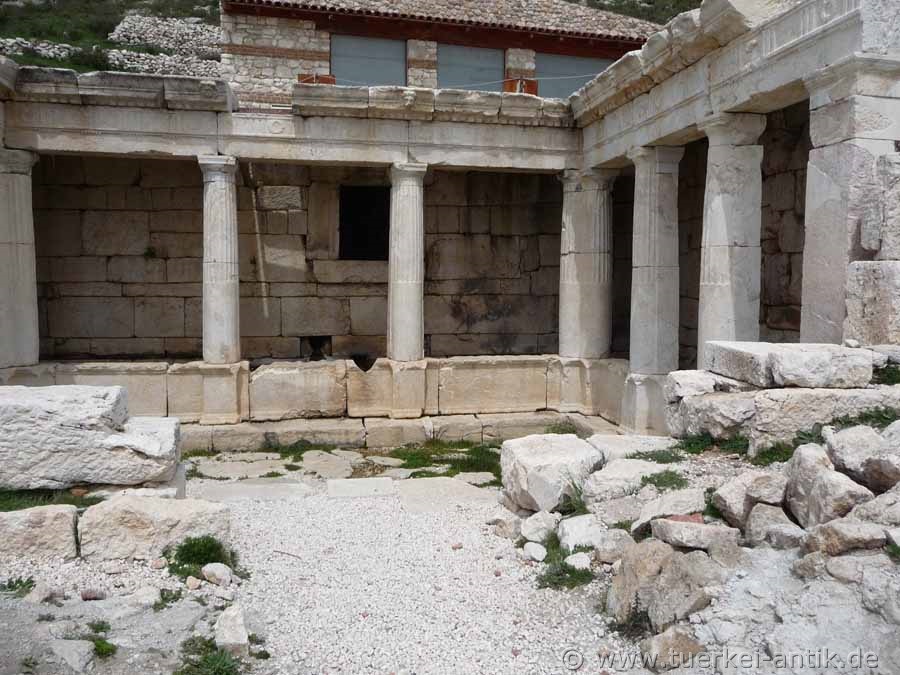 |
| Sagalassos | |||
|
|
|
||
| The Antonine Nymphaeum (161-180 A.D.) | |||
|
Sagalassos was founded in the Hellenistic period and abandoned after a severe earthquake in the early 7th century AD during the Late Antique Early Byzantine period. Apparently the ruined city remained untouched and almost unplundered to the present day, although fragments of columns, buildings and fragments of clay signal to the untrained eye an extensive, in its heyday very prosperous ancient city. |
|||
|
|
|||
| The Heroon | |||
|
When Alexander the Great conquered Sagalassos on his way to Persia in 333 BC, it was already one of the wealthiest cities in Pisidia. Several thousand inhabitants may have lived in the city. After Alexander's death, the region became one of the territories of Antigonos I. Monophthalmos (321 to 301 BC), possibly Lysimachus (301 to 281 BC), the Seleucids of Syria (281 to 189 BC) and the Attalids of Pergamon (189 to 133 BC). Archaeological evidence shows that Hellenistic culture was quickly adopted by local residents. |
|||
|
|
|||
| Hellenistic well house | |||
|
In the Roman Empire Sagalassos became one of the most important urban settlements in Pisidia, whereby a striking discrepancy can be observed between the probably small number of inhabitants (according to current knowledge probably well below 10,000 people) and the splendour and size of the public buildings. |
|||
|
|
|||
| The Theater | |||
|
Earthquakes repeatedly devastated the city, especially in 518, but above all an epidemic (the Justinian plague) around 542 also affected Sagalassos and probably killed about half the population. But once again the place could recover. Persian raids threatened the city around 620, and after another earthquake, which destroyed the city again in the middle of the 7th century at the latest, it was largely abandoned. The common people may have resettled the valley. Excavations revealed only signs of a fortified monastery, possibly a religious community destroyed in the 12th century. Sagalassos disappeared from all records and was forgotten. In the following centuries, debris and sediments covered the ruins of Sagalassos and because of its location it was not looted to any significant extent. |
|||
|
|
|||
| Residential buildings | |||
|
Sagalassos was fortified around 400 A.D., probably in response to the tense situation of the Empire at that time; however, the place was still important and prosperous throughout Late Antiquity; generous private houses were also built in the 6th century. |
|||
|
|
|||
|
|
|||
|
The upper Agora with the Antonius Nymphaeum, in the background the Heroon |
|||
|
|
|||
| Arch of Honour at the Upper Agora | |||
|
Sagalassos is located at an altitude of 1,450 to 1,600 m, about 90 km as the crow flies from Antalya, not far from today's place Ağlasun in the Turkish province of Burdur at the foot of the Taurus Mountains. |
|||
|
Coming from Antalya on the well developed national road D685, coming from Alanya, the D685 branches off about 1 km behind Aksu, and 2.5 km before the access to the airport, towards Isparta. After about 90 km of interesting and partly fascinating landscape you reach the signposted turn-off to Bušak/Sagalassos on the left. After another 22 km on another well-developed road the village Ağlasun. Drive straight through the village and then onto a narrow and winding road about 7 km long, but well paved, until you reach the ancient town of Sagalassos. The parking lot is at the guards' house. Coming from Kemer you take the national road D650, which you reach by simply following the signs to Burdur/Isparta. A ring road has been completed for a few years. So you don't have to drive through town anymore. 80 km after reaching the well-developed D650, you pass through the small town of Bušak. About 9 km after Bušak you reach the clearly signposted turn-off to Sagalassos on the right. After about 18 km on a narrow but also well developed road the village Ağlasun. Drive straight through the village and then onto a narrow and winding road about 7 km long, but well paved, until you reach the ancient town of Sagalassos. The parking lot is at the guards' house. |
|||
| Photos: @chim, Monika P. | |||
| Translation aid: www.DeepL.com/Translator | |||
| Source: Wikipedia and others | |||
|
|
|||


